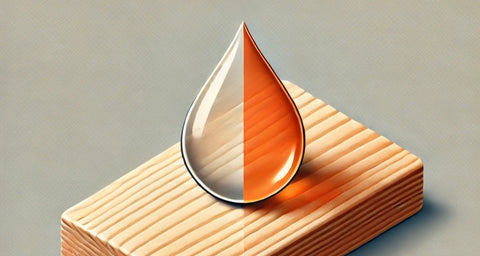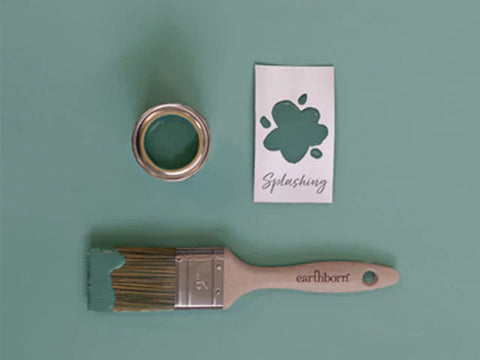Damp can sneak up on your home, often revealing itself through musty smells, peeling paint, or the dreaded sight of damp and black mould coming through walls and creeping into the corners. Don’t wait for it to take over! Catching damp early and understanding its root causes can save you a lot of trouble down the line. Whether it’s an external issue or condensation building up inside, treating and painting damp walls with the right products is essential to prevent further damage—and protect your health.

How to Identify Damp & Fix it Properly
Damp is caused by a number of factors in houses and homes, and usually only identified when black mould starts appearing in corners and behind furniture, or discolouration and paint peeling off through plaster degradation. Maybe your room just smells a little different, a slightly musty smell - a sure sign that mould is on the way (or more likely already there just hidden behind something!). If you can smell it or see it, start to sort it now. Please don’t wait, as black mould is really bad for your health, and spreads very quickly and causes all kinds of damage.
Listen whilst you're out and about instead! This video was auto created using AI from this blog post using NotebookLM to assist those who prefer this format. The blog post was written by yours truly! Transcript available here
Quick links
- Range of anti mould paints
- Auro 327 Anti Mould Paint / Breathable
- Auro 303 Anti Mould Paint / Breathable (Higher grade)
- Auro 412 Anti Mould Spray
What leads to damp walls in the first place?
Water absorption from external factors. Water from outside coming in.
One, water is being absorbed through the wall and ending up on the inside. This is usually due to an external factor that has changed, such as a gutter leaking, or shrubs / plants / moss growing right up against the house (check if you have wisteria, ivy etc as this can also be a factor. If you have a damp internal wall, check for water leaks from showers, baths, pipes, or even check if it’s coming from the roof or loft. Try to identify the simple stuff first!
Bricks require direct contact with the air, and moving air where possible, the wind and breeze soon wicks away moisture from the rain soaked bricks ‘as designed’, but when gutter fail so bricks and render are permanently wet this can cause damp on the inside.
Modern homes have a cavity between the two brick walls, which should also allow the moisture to be wicked away by the drier air and back out through the air bricks. However, there have been all kinds of cowboys filling voids with foam and all kinds of things - which stop the airflow and allow the internal bricks to become damp.
Moisture absorption from internal factors. Moisture from inside trying to get out!
“The damp proof course has failed” or “we have rising damp” is most often heard when people first make assumptions about why they have mould and damp internal walls. If you’ve checked the outside exterior face of this same wall and there are no external ‘fails’ like a broken gutter, foliage, moss and other signs as mentioned previously, the chances are it’s not damp proof issues, or even rising damp.
“You’ve got Rising damp” has spawned a million pound industry of rank chemical wall injections and other absolute tosh as millions of unsuspecting homeowners believe the hype and ‘invest’ thousands from snake oil salesmen.
9 times out of 10, moisture and damp walls are caused by, wait for it, you. Bathrooms, kitchens, cooking, breathing!

In modern times of flat pack housing, plastic paints and non breathable materials and structures, with little thought given to air movement and air flow, it’s not surprising that our homes are primed for mould and damp.
Off the shelf big brand paints are mostly plastic, and trap water in all the wrong places.
Why was this not a problem historically? Traditional homes just weren’t ‘sealed’ in the same way, air was able to flow, windows had gaps (and were open more). Houses didn’t have internal heating systems keeping some walls warm and some cold causing condensation. Traditional houses use lime plasters and breathable paints which absorb moist air and then breathed it out again, self regulating homes and rooms.
A family of humans breathing out warm moisture filled air all day and night, in a house with inadequate airflow, and a habit of over-filling rooms, and a habit of having large furniture up against walls is a key factor. All these factors combined leads to mould buildup and damp walls that just can’t dry out.
Twin that with plastic paints that ‘seal’ surfaces, trap moisture behind the paint leading to blowing paint and plaster, and generally degrading the surfaces.
What about condensation?
Yep. The condensation building up on he inside of your windows is due to the temperature difference between in the inside and exterior surfaces, causing the damp wall air from inside to condense as it cools, sticking to the inside of your windows

So where do you think this water goes if you don’t ventilate? Further in your room, increasing the humidity and helping to create perfect conditions for mould to form. If you have condensation on the inside, please just open the window, even in the depth of winter, even for just 10 mins to let the majority of moisture out.
I’ve said this so many times over the years, but one of the best ways to improve your indoor air quality in your home is by upgrading your bathroom extractor fans! They offer huge return on investment.
So. Increase your airflow as often as you can, open windows after showering and also crack the windows open a little first thing in the morning in your bedroom, as a full night breathing into a small room is a prime mould site, and literally the last room you want to actually have mould in.
How to treat mould?
If you are finding mould in the corners of your room, then I suggest treating it with the natural and non toxic Auro 412 anti mould spray, and then follow up with the Auro 413 which will prevent / slow down future growth.
What about specific anti mould paints?
If you do have areas that do get regular mould that you just can’t keep on top of, use the Auro 327 Anti Mould White Emulsion (interiors) or the higher grade version Auro 303 anti mould paint (personally I’d say skip straight to that one as it’s much thicker and easier to apply). Perfect for damp garages, cellars etc, where it’s harder to control the damp.
But my damp is in my cellar or garage / out buildings!
Fair enough, these places will suffer due to thinner walls, and damp wicking through - so in this case we have a few options. Auro 327 anti mould paint or the higher grade Auro 303 emulsion are perfect for these situations.
Breathable paint for damp interior walls!
We have loads of choices for breathable emulsion for damp interior walls, and some of the best coloured natural wall emulsions we have are the Auro 555, or the Graphenstone Grafclean. However if you want something that is just white and a little naturally higher in PH (which will slow down the mould growth) then have a look at the Auro 327 or the higher grade Auro 303. All paints we stock from Auro and Graphenstone are as breathable as you’ll ever need, so whatever you chose will be perfect.
What types of paints will help damp proof interior walls?
It’s less about damp ‘proofing’ and more about regulating the moisture so it can breathe and allow the walls to dry out properly.
Breathable Paint for interior damp walls.
Top selling breathable paint would be Auro 555 coloured emulsion with Auro 524 as the white version. Graphenstone Grafclean Emulsion for interiors, coloured and white.
Anti mould paint for interior damp walls.
Auro 327 anti mould paint, or the higher quality Auro 303 would be ideal. Or the lime based Graphenstone Ecosphere which also happens to be one of the most breathable paints we offer.
Clay paint for interior damp walls
Auro have a great natural and very breathable clay paint, Auro 535 is the coloured variant and Auro 331 is the plain white variant. We also stock the Earthborn clay paint in a variety of colours. The benefit of clay paint is it is one of the most breathable types of interior wall paint, especially the Auro range.
Lime Wash for interior damp walls
Lime based paints are great for interior walls as the have a higher PH level as standard, which slows down the growth of mould on damp walls. We have a modern Lime paint from Auro, Auro 344 which is excellent, as well as a top interior lime paint from Graphenstone, the Ecosphere. If you would like a more traditional limewash for your period heritage property, then have a look at the lime earth range.
Exterior Masonry Paint for damp walls
For exterior masonry paint, I would suggest using the Graphenstone GCS Exterior emulsion, which is an incredible modern natural exterior paint that has all the eco creds, breathable and non toxic. Just use this one (may require the L42 primer, see data sheet)
How to Prep and Paint to Treat Internal Dampness
- Clean black mould off walls using the Auro 412 mould spray
- Leave to dry, and then dust wall.
- Choose your paint, and apply primer if required.
- Paint top coat, usually 2 coats would be required.
- Remember to ventilate your bathroom and bedroom in the morning if you can, to prevent mould buildup in the future.
Exterior Masonry Paints




